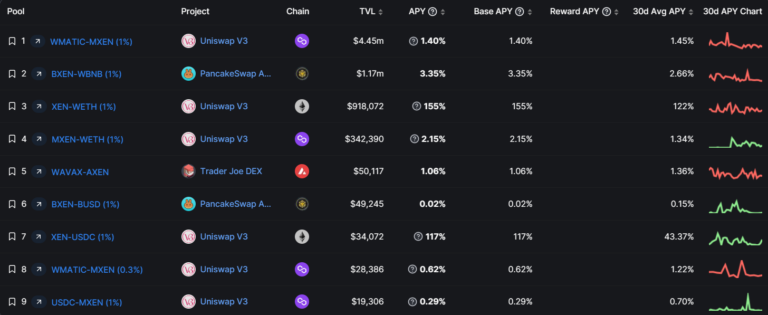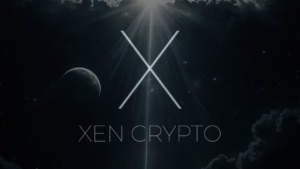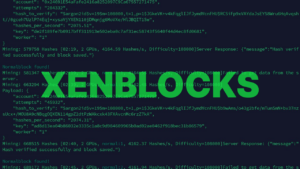In the realm of blockchain ecosystems, XEN stands as a distinctive token due to its free minting mechanism, which intimately connects it to the economies of underlying networks. With its production costs and influence on the deflationary mechanisms of Ethereum and other network coins, XEN exemplifies the intricate interplay between token economics, network dynamics, and overall market conditions. Here, we delve into the multifaceted nature of XEN, exploring its ties to the underlying network’s economy, its impact on gas prices, the deflationary effects on network coins, and how these factors shape its price, liquidity, and overall market behavior. By dissecting these elements, we can unravel the complex relationship between token economics, network dynamics, and the broader landscape of blockchain economics.
XEN accessibility and low barriers to entry
XEN’s primary value proposition lies in providing the lowest barrier to entry into the blockchain ecosystem. By offering the token for free, it enables individuals from diverse backgrounds, including those in poorer countries, to participate in the blockchain revolution. This accessibility allows more people to engage with decentralized applications, financial services, and other blockchain-based opportunities.
XEN’s presence on multiple networks expands its reach and potential user base. While Ethereum remains the oldest and most secure network, other networks where XEN was deployed (BSC, Avalanche, Polygon, Fantom, PulseChain, Evmos, Ethereum PoW, Moonbeam, Dogechain, OKX Chain) cater to populations from different regions because of the lower cost, the founding team, and marketing.
One of the fundamental principles of blockchain technology is censorship resistance. While XEN has faced instances of censorship on Dogechain and OKX Chain, the decentralized nature of Ethereum and other networks minimizes the risk of censorship. XEN’s presence on multiple networks ensures that users have alternative options, reducing the potential impact of total censorship attempts. While the tickers remain different, the XEN brand is a unifying force.
The economy of XEN
XEN’s economic value benefits from the network effects it generates. As more users adopt XEN and engage with the ecosystem, the token’s value can appreciate. The growing user base fosters liquidity, which enhances XEN’s market dynamics and attracts further participants. This positive feedback loop strengthens XEN’s value proposition, creating an ecosystem where participants contribute to the token’s growth and overall success. Network growth is at the base of Metcalfe’s law, which states that a network’s value is proportional to the square of the number of connected users in the system.
XEN experiences significant price variations across the networks. It can be attributed to the prevailing market dynamics and network-specific factors. In networks with lower gas fees, the price of XEN may be comparatively lower due to reduced production costs. Conversely, on networks with higher gas fees, the cost of producing XEN increases, reflecting its higher price. These variations emphasize the importance of considering network conditions and associated costs when assessing the value of XEN.
| Ticker | Gas units | Gas price in $ | 1$ buys |
| XEN | 23 | 10.94 | 964,320 |
| dcXEN | 0.0 | 0.0 | 14,703,720 |
| pXEN | 965236 | 0.03 | 46,146,747 |
| aXEN | 25 | 0.10 | 63,011,972 |
| bXEN | 3 | 0.17 | 139,256,371 |
| mXEN | 82 | 0.02 | 183,688,464 |
| mbXEN | 134 | 0.01 | 195,656,427 |
| fmXEN | 1900 | 0.14 | 688,705,234 |
| okXEN | 0.10 | 0.02 | 1,243,935,813 |
| vvXEN | 0.13 | 0 | 3,920,031,360 |
| coXEN | 20 | 0 | 6,854,009,596 |
XEN mint is tied to a logarithmic function where time plays a major role. As time progresses, more time is required to mint the same amount of XEN. Higher gas costs require more time to offset this cost. Very short term mints are unprofitable on most networks. This is due to both the price of gas and the price of XEN.
Chain | Term | Gas | ClaimRank | XEN price |
Ethereum | 166 | 13.72 | 0.002195 | $0.0000009011 |
BSC | 623 | 3 | 0.000458 | $0.000000006633 |
Polygon | 89 | 91.32 | 0.014611 | $0.000000004741 |
Avalanche | 155 | 59 | 0.004000 | $0.00000001513 |
Ethereum PoW | 57 | 1.47 | 0.000234 | $0.0000000002398 |
Moonbeam | 122 | 152.71 | 0.024560 | $0.000000005898 |
Evmos | 72 | 21 | 0.003360 | $0.0000000001551 |
Fantom | 463 | 634.72 | 0.101550 | $0.000000001394 |
Dogechain | 4 | 250 | 0.038193 | $0.00000006638 |
OKX Chain | 296 | 0.10 | 0.000700 | $0.0000000007770 |
PulseChain | 28 | 939808.08 | 180.428115 | $0.00000002880 |
The cost of cRank on Ethereum has seen periods of a very high price, reaching 16 dollars. That caused the price of XEN on exchanges and OpenSea to surge. There’s a correlation between the price of gas and the price of XEN. Higher gas prices cause higher XEN prices; however, it also works in reverse. When XEN’s price surges, more people mint, and gas prices rise. This has a stabilising effect on both the price of gas and XEN as people find ways to arbitrage discrepancies.
The gas cost in Ethereum is comparable to the energy usage by the Bitcoin miners. Energy costs correlate with BTC prices; however, there was a period when energy costs rose significantly and the price was low, causing the miners to cease activity or go bankrupt.
We find an instance of a similar event in XEN history when the price of the token fell below the production level of some minters. Claiming mints was unprofitable because a market buy was buying more tokens than the mint was worth. Unclaimed mints never came into existence, reducing the estimated total supply.
This could happen only as a result of a too low mint term; however, at the time of the rank claim, the future price of gas or XEN is impossible to predict. The maximum mint term is not a guarantee of a sure profit either.
Ultimately, the profitability of a mint doesn’t depend on the mint term but rather on the network conditions and the price of the token at maturity date. The minter is at the mercy of these two factors during the 7 days available for claim. Conversely, liquid XEN in the wallet leaves the freedom of endurance through the hard times.
It is worth noting, though, that in most observed cases, where the minters were weary about the cost of production and used low gas fee, the mints over a certain period of time were always profitable on Ethereum.
Liquidity and potential growth
While liquidity may be relatively low on networks other than Ethereum, it presents an opportunity for growth and market development. As XEN gains traction and user adoption expands, liquidity on these networks can increase, improving accessibility and trading opportunities for participants. Liquidity growth on alternative networks enhances the overall value proposition of XEN, attracting more users seeking cost-effective solutions. Liquidity ensures that there is always someone to trade with, even if the market is experiencing low volume or volatile prices. Without sufficient liquidity, traders may find themselves stuck holding a particular asset, unable to sell it for a profit or switch to another coin.
Ethereum has the highest liquidity and trading volume among blockchain networks. This liquidity makes it easier to buy, sell, and trade tokens on Ethereum-based decentralized exchanges (DEXs) and centralized exchanges. Higher liquidity enhances market efficiency, reduces slippage, and provides better opportunities for users to enter or exit positions. For traders and investors, the liquidity and trading volume on Ethereum often outweigh the potential cost savings from cheaper transaction fees on other networks.
The TVL in the XEN/ETH liquidity pool is almost 1 million dollars, while pools on other networks are very tiny. The base APY for liquidity providers on Ethereum is 155%, which gives a good incentive in return for the risk. Other pools may find more liquidity when demand for XEN increases. This will likely happen when X1 daily auctions start in September and dapps like XEN Token Factory, DBXENFTs, xen.game, and others come into play.
It’s important to note, though, that XEN is a special kind of ecosystem because the user is never stuck with the token when liquidity is low.
If the liquidity is low, the XEN holder can choose to burn it for DXN and earn ETH and XN rewards. OpenSea is another option, which may be a more viable exit strategy for some networks. Other kinds of burning are also an option. Burning for Apex or Limited XENFTs ensures participation in projects like xen.game and DBXENFT, potentially giving an opportunity for exit in low liquidity conditions.
Additionally, each burn gives a share of the XN allocation in the X1 chain. Instead of exchanging XEN for XN on a DEX, burning one for another gives the same result, with the exception that it potentially increases the demand for XEN and its price due to reduced supply.
While other low-market-cap tokens offer no solution to low liquidity, the XEN ecosystem has alternatives for anyone who doesn’t wish to get stuck in an investment for a long time. This is a good chance for those who see investment potential in microcap tokens but remain reticent because of liquidity.
While liquidity may currently be lower on networks other than Ethereum, as XEN gains traction and user adoption increases, liquidity on these networks can improve, providing better trading opportunities for participants.
ETH burn
A total of 45.510.22 ETH, or $87,761,909, have been used to produce XEN since its genesis on October 9th. Daily gas usage on Ethereum fluctuates depending on the cost.
On other networks, it may be more homogenous; however, there’s no data to back up this hypothesis. The ETH burn caused by the XEN minters caused ETH to become deflationary for the first time since merge.
XEN minting activity is an important factor in the larger Ethereum ecosystem. XEN is the top three token on most of the networks it exists on, but not all of them gain as much advantage in terms of deflationary effects on the supply as Ethereum.
Conclusion
XEN’s value lies in its ability to provide global accessibility to blockchain technology, with a specific focus on lowering the barriers of entry for individuals from various economic backgrounds. By being present on multiple networks, XEN ensures wider availability and reduces the risk of censorship. Although variations in XEN’s price exist across networks due to differing gas fees and market dynamics, these fluctuations reflect the underlying costs of production.
The liquidity and trading volume of Ethereum attract investors with greater capital. Higher liquidity allows for easier buying, selling, and trading of tokens on Ethereum-based exchanges, enhancing market efficiency and opportunities for users. While cheaper networks may offer cost savings in terms of transaction fees, the liquidity and trading volume on Ethereum often outweigh these potential savings, attracting traders and investors. As XEN continues to grow, liquidity on alternative networks has the potential to increase, further enhancing its value proposition and utility.
















